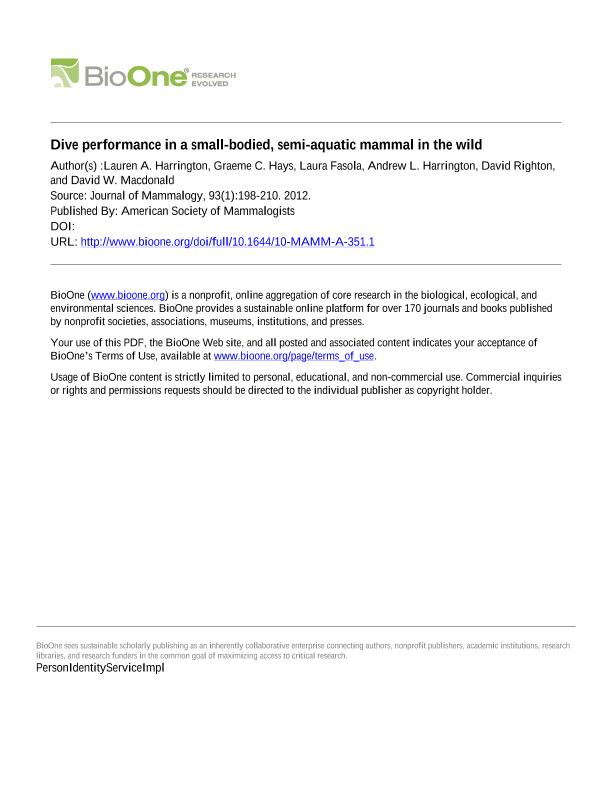Mostrar el registro sencillo del ítem
dc.contributor.author
Harrington, Lauren
dc.contributor.author
Hays, Graeme C.
dc.contributor.author
Fasola, Laura

dc.contributor.author
Harrington, Andrew L.
dc.contributor.author
Righton, David
dc.contributor.author
Macdonald, David W.
dc.date.available
2021-03-15T11:37:14Z
dc.date.issued
2012-02
dc.identifier.citation
Harrington, Lauren; Hays, Graeme C.; Fasola, Laura; Harrington, Andrew L.; Righton, David; et al.; Dive performance in a small-bodied, semi-aquatic mammal in the wild; Alliance Communications Group Division Allen Press; Journal of Mammalogy; 93; 1; 2-2012; 198-210
dc.identifier.issn
0022-2372
dc.identifier.uri
http://hdl.handle.net/11336/128309
dc.description.abstract
Aquatic foraging is a fundamental component of the behavior of a number of small mammals, yet comprehensive observations of diving are often difficult to obtain under natural circumstances. Semiaquatic mammals, having evolved to exploit prey in both aquatic and terrestrial environments, are generally not as well adapted for diving (or for life in the water) as are fully aquatic species. Because dive ability also tends to increase with body size, small, semiaquatic mammals are presumed to have fairly limited dive ability. Nevertheless, diving plays an important role in food acquisition for many such species. We used time–depth recorders (TDRs) to measure and describe the dive performance of 9 female and 5 male free-living American mink (Neovison vison; body mass approximately 1 kg) on lowland rivers in the southern United Kingdom. We recorded dives up to 2.96 m deep (maximum depth X ¯ 5 1.82 m) and up to 57.9 s in duration (maximum duration X ¯ 5 37.2 s). Dive duration was approximately 40% of that predicted by allometry for all air-breathing diving vertebrates (as might be expected for a small, semiaquatic animal) but was twice as long as previously measured for mink in captivity. Mink performed up to 189 dives per day (X ¯ 5 35.7 dives/day), mostly during daylight, and spent a maximum of 38.4 minutes diving per day (X ¯ 5 7.6 min/day). Some individuals maintained particularly high diving rates over the coldest months, suggesting that the benefits of aquatic foraging in winter outweigh the costs of heat loss. We observed a number of very shallow dives (depth approximately 0.3 m) of particularly long duration (up to 30 s). The function of these dives is currently unknown, but possibilities include searching for prey, travelling, or avoidance of threats. There is only 1 other study of which we are aware that presents detailed measurements of dive performance in a small, shallow-diving, semiaquatic mammal.
dc.format
application/pdf
dc.language.iso
eng
dc.publisher
Alliance Communications Group Division Allen Press

dc.rights
info:eu-repo/semantics/openAccess
dc.rights.uri
https://creativecommons.org/licenses/by-nc-sa/2.5/ar/
dc.subject
AQUATIC FORAGING
dc.subject
DATA LOGGER
dc.subject
MINK
dc.subject
MUSTELID
dc.subject
NEOVISON
dc.subject
TDR
dc.subject
TIME-DEPTH RECORDER
dc.subject.classification
Ecología

dc.subject.classification
Ciencias Biológicas

dc.subject.classification
CIENCIAS NATURALES Y EXACTAS

dc.title
Dive performance in a small-bodied, semi-aquatic mammal in the wild
dc.type
info:eu-repo/semantics/article
dc.type
info:ar-repo/semantics/artículo
dc.type
info:eu-repo/semantics/publishedVersion
dc.date.updated
2021-02-10T17:00:22Z
dc.journal.volume
93
dc.journal.number
1
dc.journal.pagination
198-210
dc.journal.pais
Estados Unidos

dc.description.fil
Fil: Harrington, Lauren. University of Oxford; Reino Unido
dc.description.fil
Fil: Hays, Graeme C.. Swansea University; Reino Unido
dc.description.fil
Fil: Fasola, Laura. Consejo Nacional de Investigaciones Científicas y Técnicas. Centro Austral de Investigaciones Científicas; Argentina
dc.description.fil
Fil: Harrington, Andrew L.. University of Oxford; Reino Unido
dc.description.fil
Fil: Righton, David. No especifíca;
dc.description.fil
Fil: Macdonald, David W.. University of Oxford; Reino Unido
dc.journal.title
Journal of Mammalogy

dc.relation.alternativeid
info:eu-repo/semantics/altIdentifier/doi/https://doi.org/10.1644/10-MAMM-A-351.1
dc.relation.alternativeid
info:eu-repo/semantics/altIdentifier/url/https://bioone.org/journals/journal-of-mammalogy/volume-93/issue-1/10-MAMM-A-351.1/Dive-performance-in-a-small-bodied-semi-aquatic-mammal-in/10.1644/10-MAMM-A-351.1.short
Archivos asociados
